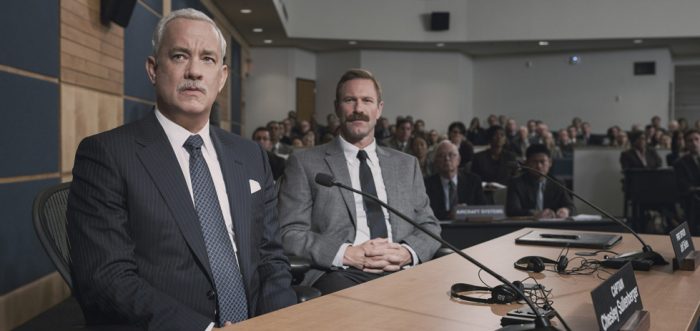
It’s easy to see what drew Clint Eastwood to Sully. Mere moments after take-off on January 15, 2009, US Airways Flight 1549 ran afoul of a flock of birds, and pilot Captain Chelsey “Sully” Sullenberger averted disaster by successfully landing the damaged plane in New York’s Hudson River—saving all 155 on board and becoming something of a folk hero in the process. It was a selfless and stoic rescue in the line of duty, performed under pressure and according to individual instinct: procedure and, by extension, bureaucracy, be damned—the American ideal. But that’s just one element to this rich and deceptively straightforward film. There’s a scene midway through in which Sully, facing the very real possibility of being found culpable for pointlessly wrecking his employer’s plane, wonders whether his 40-year aviation legacy might be ruined on account of one late-career error. Applied as an analogy to Eastwood’s late (late-late?) career—where fashionable, simplistic discourse threatens to overwhelm the 60-odd-year contribution of an American movie icon—Sully acquires another layer of resonance. What if Eastwood were to go down in history as an old man yelling at a cloud thanks to a few stray remarks in his twilight years?
Time has the tendency to yield a better perspective than grasping social media takes, of course. Point being, Sully is much more than simply a celebration of dutiful bravery—it’s deeply obsessed with the anxieties of the career individual, whose livelihood might be destroyed by a system that advocates corporate accountability over free thinking ingenuity in the face of crisis. With his trademark, no-fuss classicism—refreshing in an era of often hollow auteurism—Eastwood allows these themes to develop without overplaying the film’s hand, or more importantly losing sight of Sully’s remarkable personal account in the process.
No doubt the film benefits from the lead role going to the one actor who can still conceivably portray a real life hero: American cinema’s favourite citizen, Tom Hanks. Beloved of pop geniuses from Spielberg to Jepsen, Hanks makes for a curious Hollywood liberal counter-presence to his director’s famously conservative tendencies, and yet it’s Eastwood who brings out a compelling dimension to his leading man here. As Sully, Hanks is pushed by Eastwood to access the full range of his taciturn interiority, and he’s never demonstrated more quietly complex detail in a performance than he does here. Hanks is great at portraying the media-shy aviation veteran who was just doing his job, and even better at suggesting the man who might unravel if the airline safety investigation determines his actions might not have been so heroic after all.
This lifetime’s weight—of experience wracked with a creeping anxiety—taps into something affecting that will elude those who either go for the easy political takedown of Eastwood or whose primary insight into the film is that it’s a “dad movie.” Sully is freighted with the heaviness of memory, both personal and collective, on screen and off. It’s there in Eastwood’s movingly rendered flashbacks to his hero’s youth of flying fighter planes across the desert, in the conversations between Sully and his wife, Lorraine; in the fraught aerial panoramas of New York that the film surveys without the need for (much) explicit comment. The film’s exploration of anxiety isn’t limited to Hanks’ performance, either. Laura Linney’s expert turn renders Lorraine more than just a thankless “wife on the phone” role, conveying—in short space—the fears of someone for whom this kind of potential disaster is an ever-present worst-case scenario. Elsewhere, the supporting cast is stocked with character actors that exemplify Eastwood’s attentiveness—however calculated—to the working population so essential to running the city, be they airport concession stand cashiers or mid-town barkeeps, Aaron Eckhardt’s resilient first officer or a hotel manager who throws her arms around Sully in an impromptu moment of “New York loves you” (corny, yes; but effective just the same.)
As tempting as it might be to label Eastwood’s filmmaking workmanlike (no bad thing, in this case), there are clever formal decisions here that belie the matter-of-fact presentation of Sully’s story. The film begins, for instance, on a plane crash orchestrated as vivid CGI nightmare, and circles back during its runtime through three different perspectives on the incident itself. It’s not exactly Rashômon, but it does deal enough interesting variation to fuel the audience’s sense of anxiety and anticipation—a deft structural gambit in conveying a story that, as one joker amusingly suggested, could have ended in the first scene. Eastwood and his regular editor Blu Murray work minor marvels within this framework, weaving between Sully’s nauseous, computer-generated hellscapes to hard-cut flashback scenes that aren’t merely time-fillers: they mingle memory, and perspective, and thus the possibility for doubt—crucial to a story that seems to be cut and dried tale of heroics justly vindicated.
The cumulative effect of Eastwood’s stalling—or rather, maneuvering around the story to create tension—pays off in the film’s climactic courtroom scene. The courtroom nailbiter is one of the laziest dramatic moves a film can pull to tie things up, yet here Eastwood underplays the scene to immense effect, allowing the audience to witness—in real time—the computer simulations the airline company had commissioned in order to determine Sully’s culpability, if any, in ruining their plane. While the conclusion is never in doubt—as it hasn’t been from frame one—the scene is nonetheless strangely riveting, as we watch an obvious but satisfying “show, don’t tell” illustration of Eastwood’s interest in the disparity between technology and humanity. The irony, such as it is, is that Eastwood, like Sully, has wrangled the best digital tools at his disposal to complement his own sense of the human—and landed the film smoothly and stylishly in the process. That the film’s uplifting send-off makes a mighty concession to cheese—the ‘we all did this together, New York’ moment feels one sentiment removed from a Spider-man cameo—it can’t detract from the elegant, often emotionally fraught events preceding it.
Around the Staff
| Sam Dickson |
